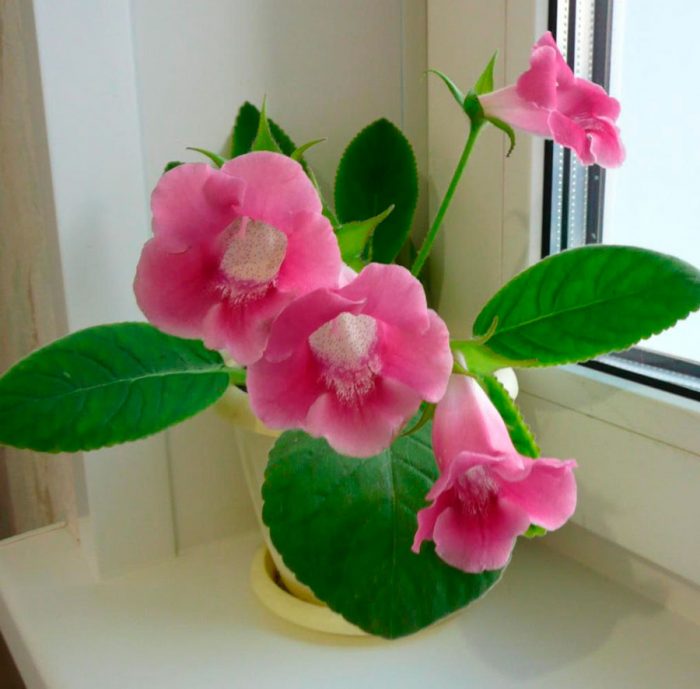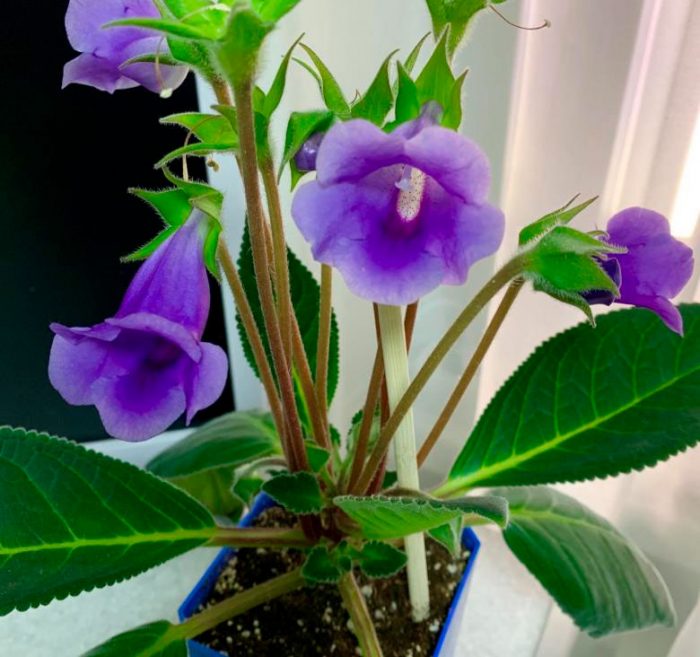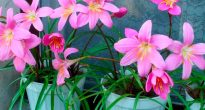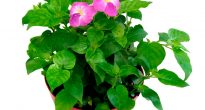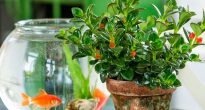The compact perennial plant Tydaea belongs to the Gesneriev family. In nature, it can be found in the tropical rainforests of South America. At the same time, Tydea comes from Brazil. In the wild, 2 forms of this plant are distinguished: semi-shrub and herbaceous. The height of the bush is about 50 cm.In a room likea, the height, as a rule, does not exceed 0.3 m.
The plant has a tuberous root system, as well as drooping or upright stems. Long-petiolized large foliage has an ovoid shape. There is pubescence on the surface of bright green leaves. During flowering, small bell-shaped flowers are formed, their corollas have a pink or purple tint.
It is quite simple to care for a room idea, so it is quite suitable for inexperienced florists. Flowering begins in the last days of spring and ends in early September. This perennial is a slow-growing plant.
Content
Brief description of cultivation
- Temperature... In the spring-summer period - around 23 degrees, and in the cold season - from 15 to 18 degrees.
- Air humidity... Slightly elevated or moderate.
- Illumination... Sunlight should be diffused and moderate. Poor lighting leads to a lack of flowering, and due to too bright light, yellowing of the foliage is observed.
- Watering... During intensive growth, it should be abundant (frequency - 2 or 3 times in 7 days). During the rest period, the soil mixture in the pot is very poorly moistened (no more than once a week).
- Soil mixture... Purchased soil mixture should be slightly acidic and light. Homemade substrate should be composed of sand, peat, humus and leafy soil (1: 1: 1: 2).
- Fertilizer... During intensive growth, they are fed once every 30 days, using a solution of liquid fertilizer for flowers in a weak concentration.
- Transfer... If necessary, when the tubers become cramped in the pot.
- Reproduction... Cutting, seed method and dividing tubers.
- Dormant period... In winter, a rest period is required. If it is warm, it will continue to grow, which will lead to shrinking foliage, strong elongation of shoots, and also to a lack of flowering.
Caring for the idea at home
Bloom
Tidea in indoor conditions blooms in the last days of May, and fades in early September.Small pink or purple drooping bell-shaped flowers form on the bush.
Temperature
This plant belongs to the thermophilic. During the growing season, the optimum air temperature is from 22 to 25 degrees. When the flower is dormant, it should stand in a cool place (about 15 degrees).
Air humidity
In the spring-summer period, the tedea needs a slightly high humidity. Therefore, experts advise, systematically humidify the air around the plant from a spray bottle. Remember that moisture should never get on the surface of flowers and leaf plates. Otherwise, unattractive brownish stains will form on their surface. To increase the humidity, a safer method is also used: wet expanded clay is poured into a deep pallet, on which a pot with a plant is placed on top.
Illumination
This indoor culture feels best in moderate lighting, which should also be diffused. The bush must be protected from direct sunlight, otherwise dark spots will form on the surface of its leaves, which represent burns.
Watering
During the growing season, the soil mixture in the pot should be moistened abundantly with a frequency of 1 every 3 or 4 days. Remember that watering can be carried out only after the top layer of the substrate dries slightly. In the autumn-winter period, watering can vary from moderate to scarce, since rot can appear on the tubers due to the large amount of moisture in the soil mixture.
Water the tedea with soft water, the temperature of which should be slightly higher than room temperature.
Pot
For planting such a plant, you can use any pot that will be slightly larger in size than the volume of the root system. At its bottom, there must be drainage holes, which are needed to prevent stagnation of moisture in the substrate.
Soil mixture
A suitable potting soil should be slightly acidic, light and well-drained. To prepare it with your own hands, you should combine humus, perlite (or coarse sand), leafy soil and peat (1: 1: 2: 1).
Fertilizer
Top dressing is carried out in spring and summer 1 time in 4 weeks. To do this, use a solution of liquid mineral complex fertilizer for indoor flowers, and its concentration should be weak.
Tidea transplant
Since tydea belongs to slow-growing crops, it does not need frequent transplants. They are carried out in the spring 1 time in 2 or 3 years. The bush should be transplanted very carefully using the transshipment method.
Pruning
If desired, the bush can be systematically subjected to a shaping haircut. In this case, it will always look neat and effective. However, pruning is not required. Also, in order for the tydea to always look neat, it is necessary to systematically tear off drying shoots, leaf plates and flowers.
Dormant period
Around mid-October, the stems and foliage begin to dry at the bush. This means that the plant goes into a dormant state. Its ground part should be cut off completely, while the tubers remaining in the pot are rearranged in a place where it is always cool and dark.
Remember to sparsely water the potting soil from time to time. At the very beginning of spring, tubers are transplanted into a new soil mixture, or the pot is simply taken out to a bright and warm place. Soon after, the bush will begin to grow actively.
Reproduction methods
Seed method
Sowing seeds in a light soil mixture of thesea is carried out in the last winter weeks, while they do not need to be buried or covered with a substrate on top. Cover the container with foil or glass and put it in a warm place (22-24 degrees). The first seedlings should appear in about 7 days. When 2 or 3 pairs of true leaf plates have formed on them, they should be cut into separate small pots.
Cuttings
Apical cuttings are used for reproduction. The places of the cuts are treated with an agent that stimulates the growth of roots, after which the cuttings are rooted in a moist soil mixture or in a glass of water. As a rule, the roots appear after 7-15 days. When this happens, they are planted in permanent small pots, which are filled with fertile soil mixture.
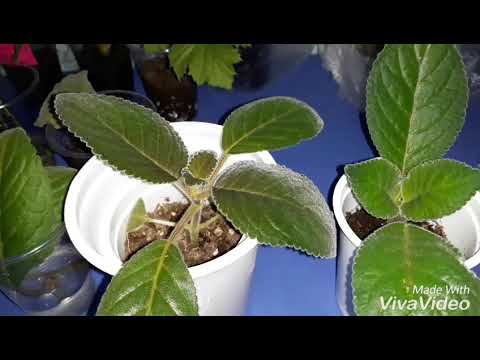

Watch this video on YouTube
Tuber division
During transplanting, which takes place in the spring, large adult tubers can be divided into several parts if necessary. Each section should be approximately 40 mm long. Do not forget to treat the cut sites with charcoal powder. Delenki are planted in a mixture of sand and peat, while they need to be buried only 20 mm. After the awakening of new shoots from dormant buds, young bushes are planted in small pots filled with fertile soil mixture.
Possible problems
With regular violations of the rules for caring for a room theme, various problems may arise with it. For example:
- Brown specks form on the foliage... This happens when the potted soil is moistened with too cold water in the evening. Remember that watering should be carried out exclusively in the morning, while the water must be well settled and not cold.
- Strong pulling of the bush... Excessively poor lighting. Move the flower to a lighter spot. If in the winter time the Thidea is not in a state of rest, then she should organize artificial supplementary lighting.
- Yellow foliage... Due to the excess of nutrients in the substrate. To prepare the nutrient solution, use ½ of the manufacturer's recommended dosage, which can be found on the fertilizer package.
- Twisting and flying foliage... Excessively dry air in the room. Systematically humidify the air around the bush or place the flower pot on a tray filled with damp expanded clay.
- Lack of flowering... Acute lack of nutrients or poor lighting. Move the bush to a sunnier place and, if necessary, feed it.
Of the pests, thrips, spider mites, mealybugs and aphids can settle on the flower. For their destruction, use suitable acaricides or insecticides.
Interesting Facts
Beginners in floriculture often believe that tydea, coleria and gloxinia are one and the same plant. However, it is not. These are three different indoor crops that differ in color and flower shape. Tydea differs from the other two plants in that its flowers are bell-shaped, and they can be painted in a pink or purple hue. Gloxinia has cupped flowers, while in Coleria they are painted in other shades.
Superstitions and omens
The room idea is assigned powerful mystical properties. It is believed that she is able to improve the material well-being of her owner, as well as change his life for the better. Tydea may well decorate a children's room. It is believed that she helps moody babies to become calmer.
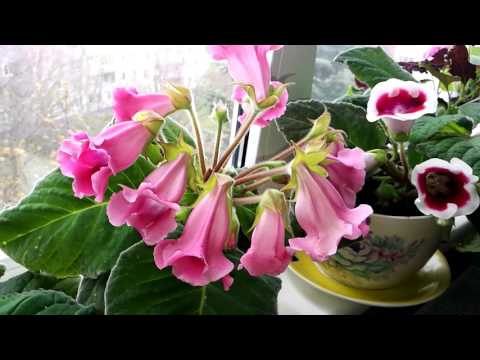

Watch this video on YouTube



